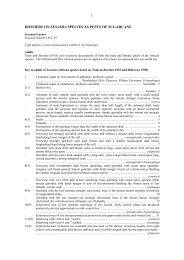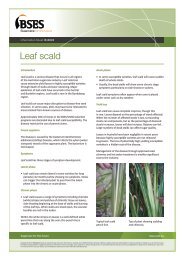You also want an ePaper? Increase the reach of your titles
YUMPU automatically turns print PDFs into web optimized ePapers that Google loves.
IMAGE 1 | Spores of the protozoan disease Adelina in the haemolymph (‘blood’) of a<br />
greyback canegrub (CSIRO photograph).<br />
TABlE 2 | Percentage of greyback<br />
canegrubs infected with the grubdisease<br />
Adelina in a survey of canefields<br />
with or without a soybean rotation<br />
before planting (numbers in brackets<br />
are number of fields surveyed).<br />
Region % with different<br />
rotations<br />
Central<br />
Herbert<br />
Innisfail -<br />
Tully<br />
Mulgrave<br />
Combined<br />
Soybeans No rotation<br />
5 (4)<br />
26 (8)<br />
14 (2)<br />
24 (9)<br />
21 (23)<br />
2 (17)<br />
11 (19)<br />
16 (17)<br />
18 (<strong>25</strong>)<br />
12 (78)<br />
However, similar results were not seen<br />
in central Queensland where the disease<br />
is very uncommon. Changes to farming<br />
systems in districts where pathogens are<br />
currently rare are unlikely to bring about<br />
rapid change in grub disease status in<br />
those fields.<br />
CONTrOLLeD-TrAffiC<br />
AND reDuCeD TiLLAGe<br />
Tillage, even if very intensive, will not<br />
eliminate existing canegrub infestations or<br />
prevent new ones.<br />
for example, canegrubs were sampled in<br />
soybeans that had either been (i) directdrilled<br />
into cane that had been sprayed<br />
out with glyphosate or planted after cane<br />
stools had been disced out; or (ii) planted<br />
after full cultivation (eg plough, disc and<br />
rotary hoe). Prior intensive cultivation did<br />
not eliminate most species of canegrubs<br />
from fields – see Table 3 below.<br />
TABlE 3 | Comparison of numbers of<br />
canegrubs in (i) soybean crops that were<br />
either direct-drilled or planted after discing<br />
or (ii) planted after full cultivation.<br />
Canegrub Average grubs per<br />
hole (no. fields<br />
sampled in brackets)<br />
Greyback<br />
Southern 1-year<br />
Childers:<br />
1st yr grubs<br />
2nd yr grubs<br />
Directdrilled<br />
or disced<br />
0.9 (3)<br />
0.6 (1)<br />
0.9 (6)<br />
0.7 (6)<br />
Reduced tillage also seems to benefit<br />
canegrub control by preserving grub<br />
diseases in the soil. In far northern<br />
Queensland, infections of greyback<br />
canegrubs with the common disease<br />
IMAGE 3 | Greyback canegrub infected and killed by Metarhizium fungus<br />
(CSIRO photograph).<br />
Full<br />
cultivation<br />
0.0 (4)<br />
0.4 (3)<br />
1.1 (9)<br />
0.7 (9)<br />
IMAGE 2 | Canegrub-damaged<br />
sugarcane.<br />
Metarhizium were significantly greater<br />
in ratoon fields where fields had been<br />
prepared for planting with zonal tillage<br />
– cultivation of only the row and not the<br />
interspace – rather than conventional<br />
(full) tillage – see Table 4.<br />
TABlE 4 | Percentage of greyback<br />
canegrubs killed by the disease<br />
Metarhizium in canefields prepared<br />
for planting by either zonal or<br />
conventional tillage.<br />
District Average % infected<br />
(no. fields in brackets)<br />
Innisfail -<br />
Tully<br />
Mulgrave<br />
Combined<br />
Zonal Conventional<br />
22 (4)<br />
11 (6)<br />
15 (10)<br />
6 (14)<br />
6 (28)<br />
6 (42)<br />
IMAGE 4 | Cane stool damaged by<br />
greyback canegrub.<br />
p 1 1 i s s u e 2 5




